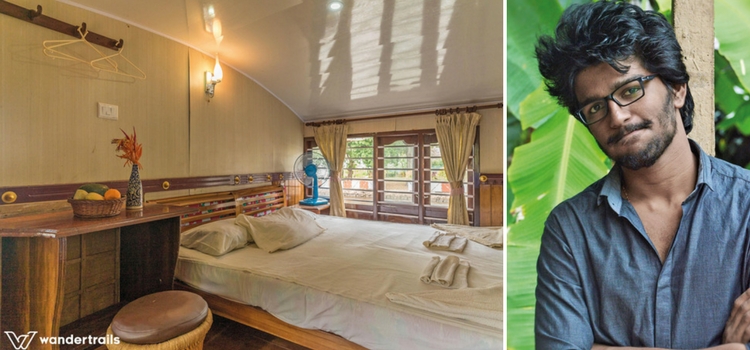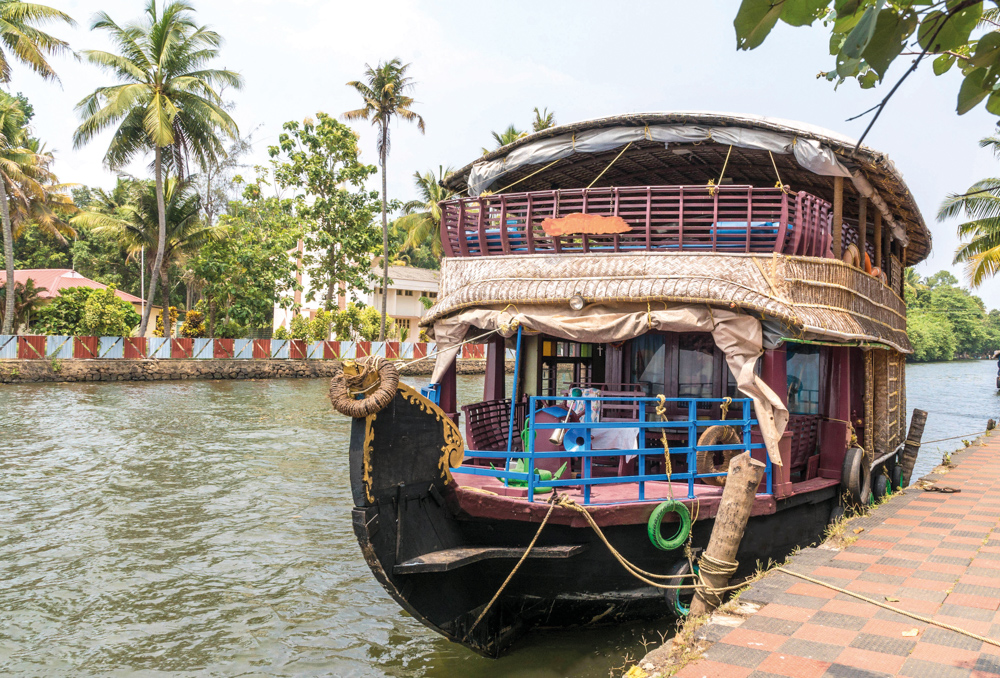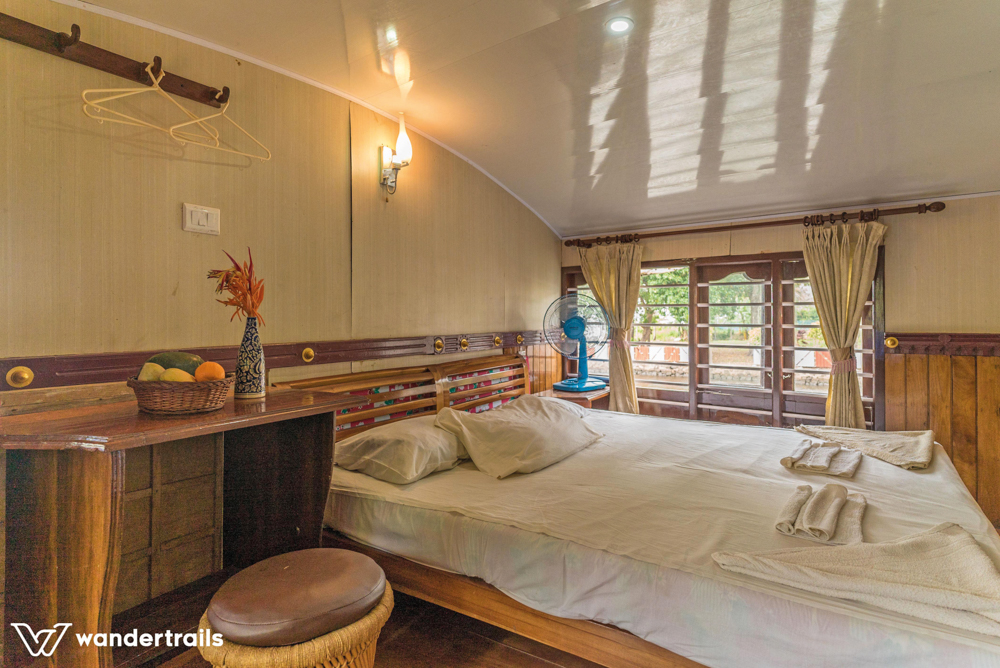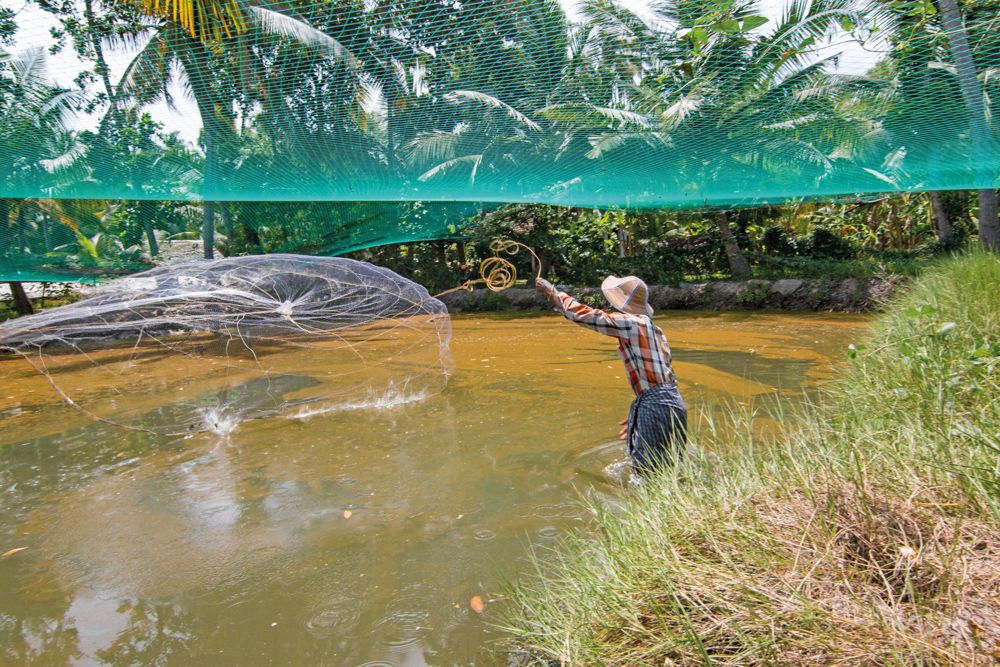Living
Kumarakom: Kerala Tourism’s Poster Boy

Nikhil Sreekandan discovers the magical beauty of his homeland through a cruise on the waters of Kumarakom
Text Credits: Nikhil Sreekandan Image Credits: Wandertrails
Hugging a steaming cuppa, I sat curled against the wooden railing of the large slow-moving barge that had accommodated us for the past day. As the sky gradually bled a bright orange, like a mirror, the lake below me reflected the rising sun’s vast canvas on its gentle waters.
Songs from a temple nearby echoed in my ears as a flock of I don’t know what specie of birds (herons maybe?) flew past. Julia would have known, herons or otherwise, but she was fast asleep in one of the rooms behind me. A wildlife enthusiast and photographer, she along with a couple of our friends from my time in the UK had come to tour India and were now on the southern leg of their tour.
From the moment I heard they were visiting Kerala, I had been perplexed as to what their itinerary would be for the two days that they were here. What would make for a true Kerala experience? But, looking back, my worries had been very much unfounded as every single one of us had thoroughly enjoyed the past day. I couldn’t have possibly picked a better choice, exploring the backwaters of Kerala in a houseboat was indeed the real Malayali experience. A shoutout to my pals at Wandertrails for setting it all up so well.

Interestingly, I had never been to Kumarakom before, let alone a houseboat, making me equally or even more curious than my foreign friends. Of course, growing up, I had heard so much about cruising over the beautiful backwaters of Kerala. Kumarakom and Alleppey were after all the poster boys of the state tourism department. But in my 25 years, I had never been there.
Making way
After a sleepover at my home in Trivandrum, we had left early in the morning for Kumarakom. We reached the Kottayam railway station by around 11 and were picked up by Mr Shanoj, the owner of the houseboat we were spending the night in. I have to stress on the fact that we made it right on time, checking in exactly at 12.00pm.
Located 16km to the west of Kottayam and on the banks of Kerala’s largest lake – Vembanad, Kumarakom is a laid-back village in the serene backwaters of God’s Own Country. This tiny cluster of islands is interconnected by a network of canals, brackish lagoons, and the vast Vembanad Lake which spans across several districts.
Our abode for the night
Before we boarded the houseboat, we were introduced to the Indraprastham Cruise and its crew – Sreejith, the Captain and Vinoj, the chef. Reincarnated from the traditional ‘Kettuvallam’, which was used to carry rice and spices to the Kochi port back in the day, today’s houseboats are large floating barges fitted with all the modern living comforts, but set in a truly ethnic setting. The Indraprastham Cruise was a three-bedroom houseboat with a spacious sundeck from where we could enjoy the mesmerising views and under the large bamboo-thatched canopy lay the entire home-unit of the houseboat with three bedrooms and a small kitchen.

The backwaters have always been the emblem of Kerala’s tourism efforts and we were spellbound from the moment we started the journey. Dotted by swaying coconut trees and the tiny houses of the locals on either side of the lagoon, the Indraprastham Cruise sliced through the smooth waters with the ease and grace of a seasoned sailor. It took us a good thirty minutes before we lifted our buried noses from our DSLRs, attempting to capture the magical beauty that was unfolding in front of us, and actually enjoy it. We invaded a number of smaller canals, on either side of which lay paddy fields that stretched as far as the eye could see, before we broke into the voluminous Vembanad Lake.
Oh, yes, prior to that we took a pit stop at a local toddy shop to buy kappa meen curry aka tapioca and fish curry, and of course toddy! Vinoj promised he would catch us some fresh karimeen and fry it up for dinner, so we skipped on the karimeen fry at the shop (which I have to confess I found very difficult).
Boundless beauty
The Vembanad lake was truly boundless, stretching out into infinity; we were barely able to see the strip of land in the far horizon, merely a tiny little speck. A front-seat view of the limitless Vembanad Lake with your best mates and sweet toddy and spicy fish curry to keep you company; now that’s something you will only find on this tiny strip of land and not anywhere else. Joe took his guitar out (always a good metric to measure the mood) and soon we were all singing along to McLean, Cohen, and Lennon. That’s when the Captain decided to join in and Sreejith started ripping the uber-famous ‘Kuttanadan punjayile.’ I tried my best to sing along, suffice to say, clueless Joe did a better job with his guitar. We had some passing by fishermen cast curious glances and some of them were even clapping to our tunes, or I just might have imagined it. Need to confirm that when the others wake up, I made a mental note.
Before we knew it, the sun had started to set and we docked for the night. Vinoj delivered on his promise with some fresh karimeen, as we watched in glee at the ease with which he caught them. As the night slowly crept up on us, the air took on the aroma of fried fish, the mosquito nets came down shrouding the Indraprastham Cruise like a cocoon, and a bright moon took to the sky. Under the diffused moonlight that came in through the mosquito net, the night took on a tranquil and calming ambience, the pin drop silence only adding to the mood. Tucking in on the delicious fish fry and some more tapioca and fish curry, I had to congratulate myself for the difficult toddy shop decision; this was undoubtedly the best karimeen fry ever! With a ready to burst stomach and a happy soul, we retired to our rooms for a good night’s sleep.

A gentle breeze lifted me from my trance. The morning twilight had almost given way to that moment when the sun rose over the horizon. Leaving my now empty cup behind, but with a big smile stuck to my face, I headed for the bedroom. Indraprastham and Kumarakom had promptly delivered on the real Kerala experience, now for the bright orange cherry on the topping, the much gushed-over Kumarakom sunrise.
It took me 25 years to witness something as genuinely beautiful as the sunrise on the Kumarakom horizon, while rocking to its backwaters in a houseboat. But, I had travelled all the way to Scotland and gushed over its perennial beauty. Sometimes, it’ll surprise you, the things that you’ll unearth in your own backyard, if you ever bothered to look.
Contact Wandertrails at:
connect@wandertrails.com,
+91 9632563535
Writer Profile:
A lover of the written word for as long as he can remember, Nikhil Sreekandan works as a content specialist with Wandertrails. Interestingly, it took an Engineering degree and a gap year for him to realise that the world of words was indeed his home. When not lost in cinema, contemporary literature, or his earphones; he exercises his skills over the written word at Wandertrails across the website, social media, magazine, and blogs.
Art
Navratri 2024: Celebrating the Nine Colours and Their Significance

Navratri, the festival that spans nine nights, is one of the most auspicious and widely celebrated festivals in India. Dedicated to the worship of Goddess Durga in her nine forms, each day of Navratri holds special significance, marked by a distinct color that carries deep spiritual and cultural meaning. As we prepare for Navratri 2024, let’s explore the nine colors associated with each day, their significance, and how they inspire devotion, positivity, and harmony.
Day 1: Yellow

On Thursday, embrace the uplifting energy of yellow as you celebrate Navratri with optimism and joy. This warm and cheerful color symbolizes happiness and radiates positivity, keeping you in high spirits throughout the day.
Day 2: Green

On Friday, wear green, a color that represents nature, growth, and harmony. It evokes a sense of peace and serenity, while also symbolizing new beginnings. Let the vibrant energy of green invite tranquility and the blessings of the Goddess into your life.
Day 3: Grey

Saturday calls for the subtle sophistication of grey. This balanced color keeps you grounded and calm, symbolizing composure and understated elegance. It’s perfect for those who want to participate in Navratri with grace while making a refined style statement.
Day 4: Orange

On Sunday, adorn yourself in the vibrant hue of orange. This color embodies warmth, exuberance, and positivity. Wearing orange during Navratri invokes an upbeat energy, bringing vitality and a lively spirit to your celebrations.
Day 5: White

Start your Monday with the purity and serenity of white. Associated with innocence and spiritual clarity, this color invites inner peace and helps you connect with the divine blessings of the Goddess, offering a sense of security and calm.
Day 6: Red

On Tuesday, red takes center stage, symbolizing passion, love, and strength. As one of the most auspicious colors, red is often offered to the Goddess in the form of a Chunri. Wearing red fills you with energy, vigor, and the vibrant spirit of Navratri.
Day 7: Royal Blue

Wednesday’s color is royal blue, representing elegance, richness, and tranquility. This deep, vivid shade of blue exudes confidence and sophistication, making it an ideal choice for those who want to celebrate Navratri with style and grace.
Day 8: Pink

On Thursday, don the charming hue of pink, a symbol of universal love, affection, and harmony. Pink is a color that adds a soft touch of warmth and approachability, making it perfect for creating a loving and joyful atmosphere during the festivities.
Day 9: Purple

On the final day of Navratri, purple takes the spotlight. Associated with luxury, nobility, and grandeur, purple invites opulence into your life. Wearing this regal color while worshipping Navdurga bestows blessings of prosperity and richness, making it the perfect way to end your Navratri celebrations.
Luxury
Cartier’s New High Jewellery Collection is a Love For The Wild

In 2021, the American Museum of Natural History in New York presented Beautiful Creatures, an exhibition showcasing some of the most eccentric jewellery designs of the past century. One standout piece was the iconic crocodile necklace of Mexican actress María Félix, a loyal Cartier patron. Félix, renowned for her bold sense of style, famously strolled into Cartier’s Paris store in 1975 with her pet crocodile, requesting a necklace in its likeness. Cartier delivered, crafting two intertwined crocodiles encrusted with over a thousand emeralds and yellow diamonds. For Félix, crocodiles symbolized freedom, an embodiment of the spirit she associated with Mexico’s Golden Age of cinema.

Fast forward to today, and Félix’s wildest dreams seem to have come to life at Cartier’s latest high jewellery collection, Nature Sauvage, previewed at the historic Kursalon Hübner gallery in Vienna. Among the star pieces is the Koaga necklace, a masterful creation where a zebra clasps an emerald-cut diamond and a 6.25-carat pear-shaped rubellite in its mouth. The zebra’s form is exquisitely rendered in alternating onyx stripes and pavé diamonds, making the creature feel almost lifelike.
The relationship between animals and jewellery has deep mythological roots, often glorified through rituals and symbolism. In ancient Egypt, scarab beetles were worn as earrings to signify respect for life’s cyclical nature. Meanwhile, in Hellenistic Greece, gods and goddesses took on the forms of winged creatures in adornment. So, what is it about animal-themed jewellery that continues to captivate us? According to Amanda Triossi, a jewellery historian based in Rome, the allure lies in our primal instincts: “Wearing wild animals like panthers or tigers gives one the sense of having conquered them. It’s empowering, as if you inherit the animal’s strength and attributes.”

Cartier captures this essence beautifully in its Amphista necklace. Featuring two intertwined snakes with diamond scales set with emeralds, their heads adorned with kite-shaped diamonds, the necklace echoes ancient Chinese philosophy’s yin-yang balance. The pièce de résistance? Nine octagonal Colombian emeralds, weighing a total of 14.72 carats.
Triossi also notes that many historical heroes are often depicted draped in the skins of animals they’ve vanquished, a symbol of triumph. Today, jewellery transforms that symbol into something precious and eternal—animal skins reimagined in imperishable materials.

Later that evening, at a celebration held at Vienna’s Kunsthistorisches Museum, the largest in Austria, the enchantment of Cartier’s collection was heightened. The museum’s octagonal domes featured paintings of animals dancing with angels, setting the stage for a magical night. Guests were greeted by masterpieces such as Rembrandt’s Self-Portrait and Caravaggio’s Madonna of the Rosary, alongside Cartier page boys in their signature red hats. The evening’s soundtrack, a seamless blend of Bach and Kygo, was curated by DJ Gillian Sagansky, lending a modern twist to the classical ambiance.
The following day brought another cultural adventure—a visit to Otto Wagner’s Villa, a stunning summer palace designed by the famed architect. The paintings adorning the villa’s walls depicted animals in various forms—some caught in purgatory, others wandering the biblical bardo, with alligators restlessly emerging from swampy landscapes.
Luxury
Indian Craftsmanship Meets Italian Savoir Faire : Rahul Mishra x Tod’s

Quiet luxury was expected to dominate for a while, with many predicting that the return of bold, extravagant fashion would take its time. However, maximalism seems to be making a swift comeback, especially in the realm of designer collaborations. Hot on the heels of the vibrant, print-heavy H&M x Anamika Khanna collection, another limited-edition line has arrived, celebrating opulent luxury: Rahul Mishra x Tod’s.
As part of Tod’s T-Factory project, which features exclusive collaborations with creative innovators, this marks Indian couturier Rahul Mishra’s debut in the international accessories space.

Mishra is a true ambassador of Indian design. Along with his wife Divya Mishra, he leads his eponymous label, which has brought the essence of India to the global stage in remarkable ways. A regular at Paris Fashion Week and the first Indian designer to showcase at Paris Haute Couture Week, his creations have adorned celebrities like Zendaya and Mark Zuckerberg, and have graced magazine covers in South Korea, China, and Europe. With such a path-defining legacy, it’s no surprise that Mishra and his visionary label were Tod’s natural choice for their first-ever Indian collaboration.
Mishra describes this collaboration as a beautiful fusion of “Italian craftsmanship serving as the canvas for Indian vision.” Tod’s iconic Gommino loafers and mules, along with the Di Bag and T Timeless shoulder bag, have been reimagined with intricate resham embroidery, crystals, and sequins—all meticulously hand-embroidered at Mishra’s atelier in Noida. “It was a technically challenging process that took time to perfect. I can confidently say these are some of the finest bags and shoes you’ll ever witness, in terms of craftsmanship and longevity. Such pieces are forever,” Mishra proudly shares.

Crafted entirely between India and Italy, the limited-edition pieces from this collection are a true love letter to the artisanal heritage of both nations. “There’s a beauty in the teamwork here,” Mishra explains. “We received raw materials from Italy and worked on integrating our embroideries seamlessly into their leather. The pieces were then sent back to Tod’s, where they transformed them into stunning, three-dimensional products. In that sense, it’s been a genuine collaboration between Italy and India.”
Mishra firmly believes that the future of global design will be shaped by a global Indian aesthetic. “Just as French, Italian, British, and Japanese designs are now seen as universal,” he explains. This collaboration marks a significant step in advancing that narrative. “When you push the boundaries of ‘handmade in India’ to be respected at the pinnacle of luxury, everything else will naturally follow,” he emphasizes.
-

 Style11 months ago
Style11 months agoBridal Guide : Best Looks of Radhika Merchant Ambani
-

 Fashion1 year ago
Fashion1 year agoMost Discussed Ajrakh Saree of Alia Bhatt
-

 Entertainment1 year ago
Entertainment1 year agoThe Most Stylish Guests of Bhagya Suresh Reception
-

 Entertainment1 year ago
Entertainment1 year agoBridal Bliss : All Bridal Looks of Swasika Vijay
-

 Movies1 year ago
Movies1 year agoA Nostalgic Journey Through Love &Cinema : Best Bollywood Romantic 90s Movies
-

 AD8 months ago
AD8 months agoPopular Curtain Fabrics to Consider for Your Home
-

 Fashion1 year ago
Fashion1 year agoMajor Denim Trends You Need To Know in 2024
-

 Events9 months ago
Events9 months agoBest of Fashion Looks : Diya Krishna Wedding






























